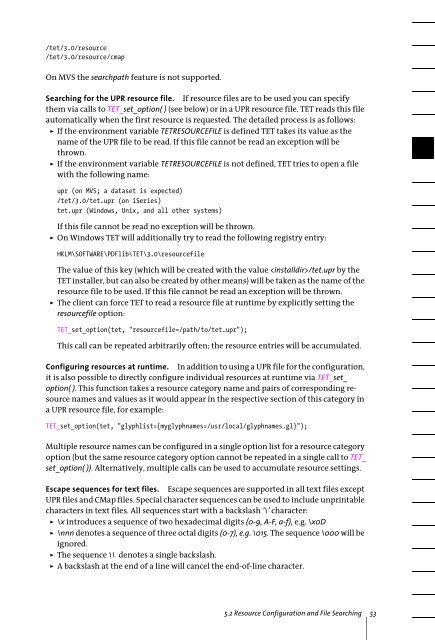PDFlib Text Extraction Toolkit (TET) Manual
PDFlib Text Extraction Toolkit (TET) Manual
PDFlib Text Extraction Toolkit (TET) Manual
Create successful ePaper yourself
Turn your PDF publications into a flip-book with our unique Google optimized e-Paper software.
tet/3.0/resource<br />
/tet/3.0/resource/cmap<br />
On MVS the searchpath feature is not supported.<br />
Searching for the UPR resource file. If resource files are to be used you can specify<br />
them via calls to <strong>TET</strong>_set_option( ) (see below) or in a UPR resource file. <strong>TET</strong> reads this file<br />
automatically when the first resource is requested. The detailed process is as follows:<br />
> If the environment variable <strong>TET</strong>RESOURCEFILE is defined <strong>TET</strong> takes its value as the<br />
name of the UPR file to be read. If this file cannot be read an exception will be<br />
thrown.<br />
> If the environment variable <strong>TET</strong>RESOURCEFILE is not defined, <strong>TET</strong> tries to open a file<br />
with the following name:<br />
upr (on MVS; a dataset is expected)<br />
/tet/3.0/tet.upr (on iSeries)<br />
tet.upr (Windows, Unix, and all other systems)<br />
If this file cannot be read no exception will be thrown.<br />
> On Windows <strong>TET</strong> will additionally try to read the following registry entry:<br />
HKLM\SOFTWARE\<strong>PDFlib</strong>\<strong>TET</strong>\3.0\resourcefile<br />
The value of this key (which will be created with the value /tet.upr by the<br />
<strong>TET</strong> installer, but can also be created by other means) will be taken as the name of the<br />
resource file to be used. If this file cannot be read an exception will be thrown.<br />
> The client can force <strong>TET</strong> to read a resource file at runtime by explicitly setting the<br />
resourcefile option:<br />
<strong>TET</strong>_set_option(tet, "resourcefile=/path/to/tet.upr");<br />
This call can be repeated arbitrarily often; the resource entries will be accumulated.<br />
Configuring resources at runtime. In addition to using a UPR file for the configuration,<br />
it is also possible to directly configure individual resources at runtime via <strong>TET</strong>_set_<br />
option( ). This function takes a resource category name and pairs of corresponding resource<br />
names and values as it would appear in the respective section of this category in<br />
a UPR resource file, for example:<br />
<strong>TET</strong>_set_option(tet, "glyphlist={myglyphnames=/usr/local/glyphnames.gl}");<br />
Multiple resource names can be configured in a single option list for a resource category<br />
option (but the same resource category option cannot be repeated in a single call to <strong>TET</strong>_<br />
set_option( )). Alternatively, multiple calls can be used to accumulate resource settings.<br />
Escape sequences for text files. Escape sequences are supported in all text files except<br />
UPR files and CMap files. Special character sequences can be used to include unprintable<br />
characters in text files. All sequences start with a backslash ’\’ character:<br />
> \x introduces a sequence of two hexadecimal digits (0-9, A-F, a-f), e.g. \x0D<br />
> \nnn denotes a sequence of three octal digits (0-7), e.g. \015. The sequence \000 will be<br />
ignored.<br />
> The sequence \\ denotes a single backslash.<br />
> A backslash at the end of a line will cancel the end-of-line character.<br />
5.2 Resource Configuration and File Searching 53
















